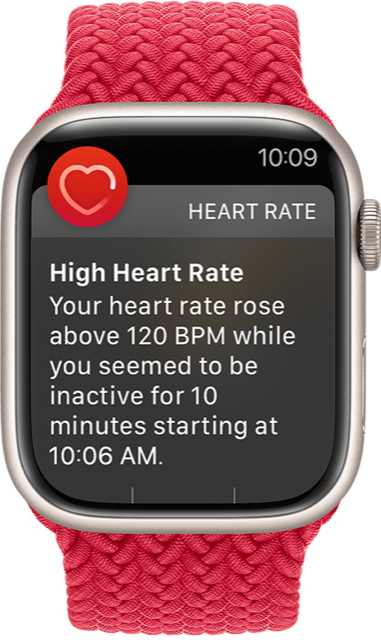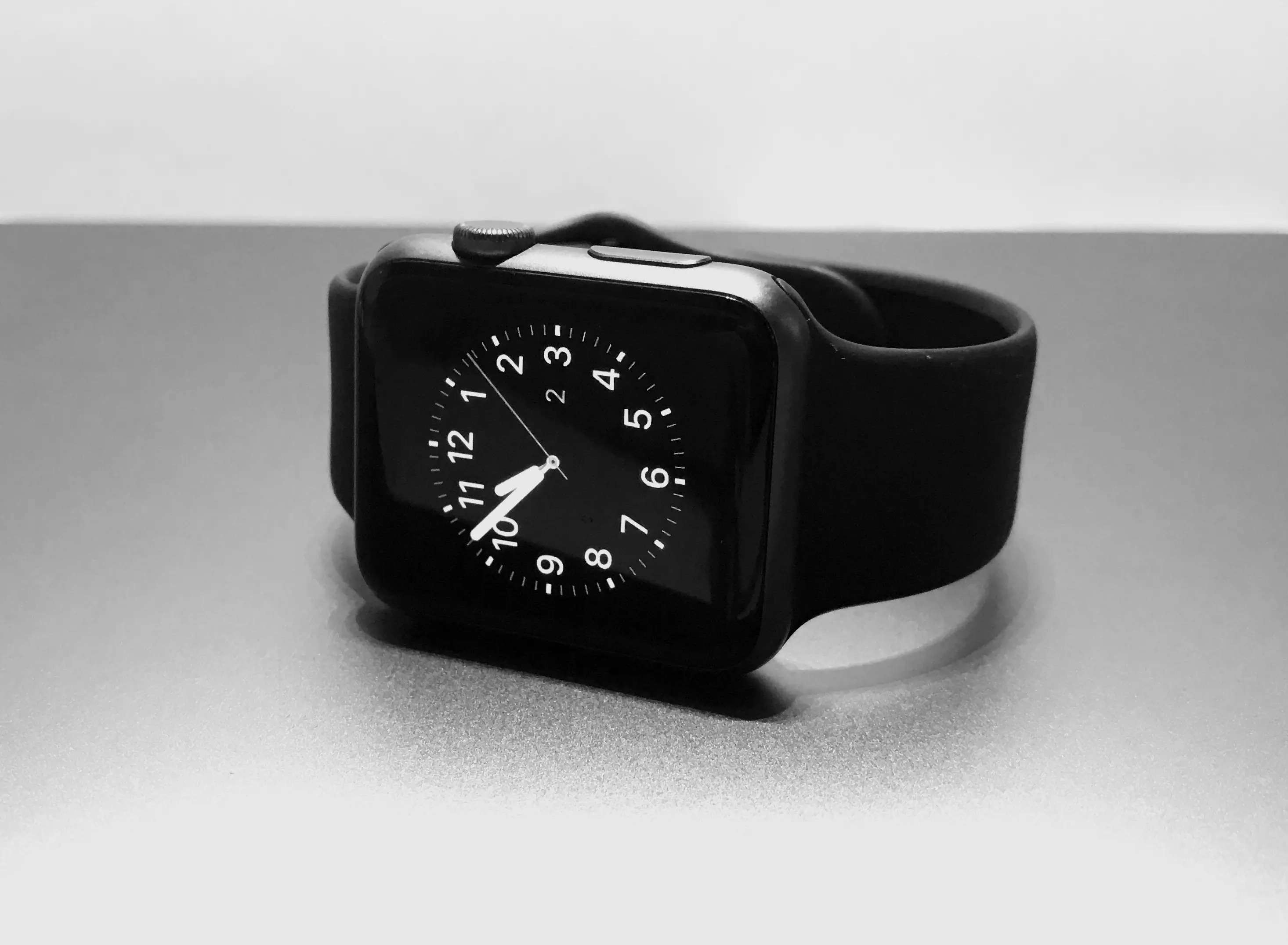Apple Watch heart-related features
The Heart Rate app on your Apple Watch alerts you to high or low heart rates and irregular heart rhythms. If your heart rate remains above or below a chosen beats per minute (BPM), your Apple Watch can notify you. These notifications are available only on Apple Watch Series 1 or later for ages 13 and up.

Here’s how you can turn on heart rate notifications on the Heart Rate app on your Apple Watch
- On your iPhone, open the Apple Watch app.
- Tap the My Watch tab, then tap Heart.
- Tap High Heart Rate, then choose a BPM.
- Tap Low Heart Rate, then choose a BPM.
Irregular rhythm notifications
Apple Watch has an irregular rhythm notification feature that will occasionally look at your heartbeat to check for an irregular rhythm that might be suggestive of atrial fibrillation (AFib).
How to enable irregular rhythm notifications
- Make sure that the software on your iPhone and Apple Watch is up to date.
- On your iPhone, open the Health app.
- Tap the Browse tab, then go to Heart > Irregular Rhythm Notifications.
- Once enabled, you can turn irregular rhythm notifications on or off in the Apple Watch app on your iPhone: Open the Apple Watch app, tap the My Watch tab, then go to Heart > Irregular Rhythm.
What if you receive an irregular rhythm alert?
Apple says that if you receive a notification, the irregular rhythm notification feature on your Apple Watch identified an irregular rhythm suggestive of AFib and confirmed it with multiple readings.
If you have not been diagnosed with AFib by a physician, you should talk to your doctor.
How do irregular rhythm notifications work
The irregular rhythm notification feature on your Apple Watch will occasionally look at your heartbeat to check for an irregular rhythm that may be AFib. This usually happens when you’re still to ensure a more accurate reading. Depending on how active you are, the number of readings collected each day and the time between these readings will vary.
What is AFib
AFib is a type of irregular heart rhythm. AFib occurs when the heart beats in an irregular pattern. It’s a common form of irregular heart rhythm where the upper chambers of the heartbeat out of sync with the lower chambers. Irregularities in heart rhythm become more common as people get older. Some individuals with AFib don’t experience any symptoms. Others experience symptoms that could include rapid heartbeat, palpitations, fatigue, or shortness of breath.

AFib can be temporary or persistent, and people with AFib often live healthy, active lives. AFib episodes can be prevented through regular physical activity, eating a heart-healthy diet, maintaining a healthy weight, and treating other medical conditions that could worsen AFib. If left untreated, AFib can lead to heart failure or blood clots that may lead to stroke. AFib can be managed with a doctor’s care and medication, and early diagnosis and treatment can prevent such complications.
ECG feature on Apple Watch
With Watch Series 4, Apple introduced the ECG feature on its smartwatch. The ECG feature truly was a significant moment in the Apple Watch history as it was a huge breakthrough and showed that health and fitness were truly a priority for the company.
What is an ECG
An electrocardiogram (also called an ECG or EKG) is a test that records the timing and strength of the electrical signals that make the heartbeat. By looking at an ECG, a doctor can gain insights about your heart rhythm and look for irregularities.
89450139
How to use the ECG app
The ECG app can record your heartbeat and rhythm using the electrical heart sensor on Apple Watch Series 4, Series 5, Series 6, or Series 7 and then check the recording for atrial fibrillation (AFib), a form of irregular rhythm.
The ECG app records an electrocardiogram which represents the electrical pulses that make your heartbeat. The ECG app checks these pulses to get your heart rate and see if the upper and lower chambers of your heart are in rhythm. If they’re out of rhythm, that could be AFib.
How to install and set up the ECG app
The ECG app is installed during the ECG app setup in the Health app. Follow these steps to set up the ECG app:
• Open the Health app on your iPhone.
• Follow the onscreen steps. If you don’t see a prompt to set up, tap the Browse tab, then tap Heart > Electrocardiograms (ECG) > Set Up ECG App.
• After you complete set up, open the ECG app to take an ECG.
89450160
How to take an ECG
You can take an ECG at any time when you’re feeling symptoms such as a rapid or skipped heartbeat, when you have other general concerns about your heart health, or when you receive an irregular rhythm notification.
- Make sure that your Apple Watch is snug and on the wrist that you selected in the Apple Watch app. To check, open the Apple Watch app, tap the My Watch tab, then go to General > Watch Orientation.
- Open the ECG app on your Apple Watch.
- Rest your arms on a table or in your lap.
- With the hand opposite your watch, hold your finger on the Digital Crown. You don’t need to press the Digital Crown during the session.
- Wait. The recording takes 30 seconds. At the end of the recording, you will receive a classification, then you can tap Add Symptoms and choose your symptoms.
- Tap Save to note any symptoms, then tap Done.
Key things to remember
Apple categorically states that the Apple Watch cannot detect heart attacks. If you ever experience chest pain, pressure, tightness, or what you think is a heart attack, call emergency services immediately.
The irregular rhythm notification feature on Apple Watch is not constantly looking for AFib. This means it cannot detect all instances of AFib, and people with AFib may not get a notification.
If you’re not feeling well, you should talk to your doctor even if you don’t get a notification. Symptoms such as a rapid, pounding, or fluttering heartbeat, dizziness, or fainting, can indicate a serious condition.
Do not change your medication without talking to your doctor.
!function(f,b,e,v,n,t,s) {if(f.fbq)return;n=f.fbq=function(){n.callMethod? n.callMethod.apply(n,arguments):n.queue.push(arguments)}; if(!f._fbq)f._fbq=n;n.push=n;n.loaded=!0;n.version=’2.0′; n.queue=[];t=b.createElement(e);t.async=!0; t.src=v;s=b.getElementsByTagName(e)[0]; s.parentNode.insertBefore(t,s)}(window, document,’script’, ‘https://connect.facebook.net/en_US/fbevents.js’); fbq(‘init’, ‘593671331875494’); fbq(‘track’, ‘PageView’);





)

More News
OnePlus Nord CE 4 to launch in India on April 1: Here’s what the smartphone will offer – Times of India
Xiaomi 14 series is now available in India: Sale, pre-booking and more – Times of India
Kiren Rijiju: Why Earth Sciences minister Rijiju is upset with this European IT company | – Times of India